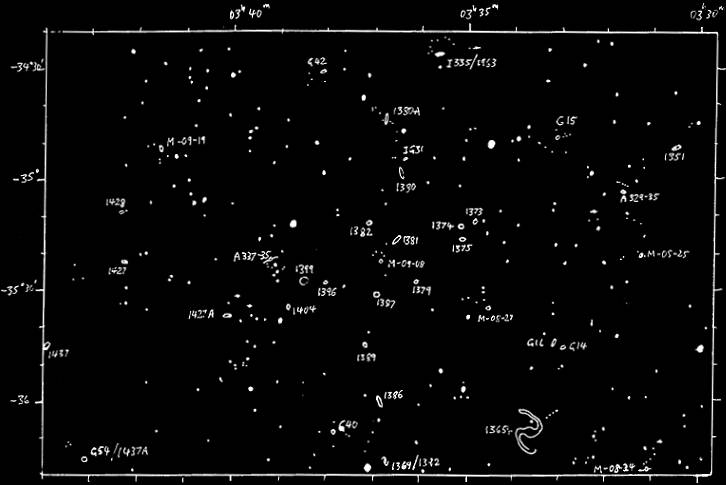BNGC 14. I Can Feel A Fornax Coming On
Back to Index of Beyond the NGC
By Steve Mencinsky, 1993
For an observer of the deepest sky, spring heralds the arrival of Fornax, a small and faint constellation, but easily recognisable as the "Y" shape of 4th magnitude stars rising in the South east. An insignificant constellation, full of deep sky significance.
One of the many delights in Fornax is NGC 1365, arguable the "best" of the barred spirals. Certainly, the spiral arms are more pronounced and easier to see than those of NGC 7479, which your correspondent understands to be the pride of the Northern barred spirals. Indeed, even the Wayne Stuart 6" "neutrino-scope" from Mt Bowen was able to demonstrate the ease with which NGC 1365's arms can be seen, which was your correspondent's first - and most memorable - view of this superb galaxy.
Nearby is the Fornax - Eridanus cluster of galaxies a prime target for supernova hunters both experienced and less so. This month's chart covers that field, showing some very faint galaxies indeed. All - yes, all - of the galaxies shown on the chart were ' successfully observed from Mt. White in an early morning sky through the 18" Johannes. The chart is drawn from a combination of Uranometria II, Andrew Murrell's chart and Joe Cauchi's photo (which was believed to have captured a supernova, but that's another story).
The field is quite famous. As pointed out by Burnham, a one degree eyepiece shows nine NGC galaxies. With Johannes, a 1.4 degree field shows a baker's dozen. In a very close decision, your correspondent rates the pair of edge-on spirals (NGC 1380 and NGC 1380A) as the most aesthetic high-power field here.
There is much more to be observed nearby, immediately outside the field drawn. NGCs 1315, 1316, 1310, 1350 and many more "anons" grace the sky immediately to the "right" of the chart, while a , few stragglers from the cluster on the chart meander off to the "left".
The labelling used in the chart needs some expansion, as several different numbering schemes are used. The "A" galaxies are Abell catalogue entries, thus for example "A337-35" is galaxy 35 in the cluster Abell 337. The "M" galaxies are MCG galaxies in band 6, thus "M-08-25" is "MCG-068-25". Finally, the "G" and "IG" galaxies are ES0 plate 450, so "G40" is "ESO-450-G40".
Finally, your correspondent is well aware that the title of this month's article has been used before in this magazine. He is, nevertheless, claiming credit for its first use in an astronomical context long before the Murrell article of the same name was anything more than a gleam in Andrew's pen.


